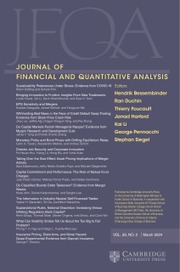Article contents
Institutional Liquidity Costs, Internalized Retail Trade Imbalances, and the Cross Section of Stock Returns
Published online by Cambridge University Press: 23 January 2025
Abstract
Order flow segmentation prevents direct interactions between U.S. retail and institutional investors. Using the imbalance in observable internalized retail trades, we show wholesalers use retail flow to provide liquidity to institutional investors, especially when liquidity is scarce. Our institutional liquidity cost ( $ ILC $) measures average absolute retail trade imbalances, positing that institutions holding stocks with greater such averages more often resort to the expensive wholesaler-provided liquidity.
$ ILC $) measures average absolute retail trade imbalances, positing that institutions holding stocks with greater such averages more often resort to the expensive wholesaler-provided liquidity.  $ ILC $ is correlated with expected institutional price impacts. Unlike existing illiquidity measures,
$ ILC $ is correlated with expected institutional price impacts. Unlike existing illiquidity measures,  $ ILC $ has economically meaningful relations with institutional holding horizons and yields annualized liquidity premia of 2.7%–3.2% post-2010, even after excluding microcap stocks.
$ ILC $ has economically meaningful relations with institutional holding horizons and yields annualized liquidity premia of 2.7%–3.2% post-2010, even after excluding microcap stocks.
Information
- Type
- Research Article
- Information
- Creative Commons
- This is an Open Access article, distributed under the terms of the Creative Commons Attribution licence (http://creativecommons.org/licenses/by/4.0), which permits unrestricted re-use, distribution and reproduction, provided the original article is properly cited.
- Copyright
- © The Author(s), 2025. Published by Cambridge University Press on behalf of the Michael G. Foster School of Business, University of Washington
Footnotes
This paper subsumes “Internalized Retail Order Imbalances and Institutional Liquidity Demand.” We thank two anonymous referees, Yakov Amihud, James Angel, Robert Battalio (discussant), Azi Ben-Rephael, Hendrik Bessembinder, John Campbell, Amy Edwards, Greg Eaton, Tom Ernst, Thierry Foucault (the editor), Terry Hendershot, Björn Hagströmer, Steven Ho, Paul Irvine, Charles Jones, Alla Kammerdiner (discussant), Mete Kilic (discussant), Pete Kyle, Marc Lipson, Liang Ma, Albert Menkveld, Josh Mollner (discussant), Dermot Murphy, Shawn O’Donoghue, Michael Pagano, Cameron Pfiffer, John Ritter, Thomas Ruchti, Gideon Saar, Andriy Shkilko, Chester Spatt, Michael Sullivan, Jose Tessada, Andrew Zhang, and seminar and conference participants at Cal Poly–SLO, the California Corporate Finance Conference, the Microstructure Exchange, Microstructure Seminars – Asia-Pacific, 2022 Santiago Finance Workshop, 2022 FMA Annual Meetings, 2023 Finance Down Under, the 10th Conference on Financial Market Regulation, 2023 Stern Microstructure Conference, and the University of Nevada at Las Vegas for helpful comments.
References
- 4
- Cited by

